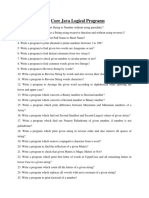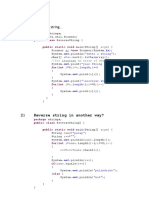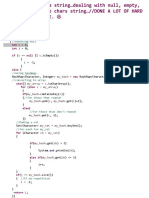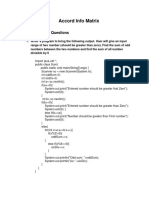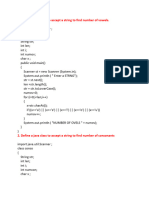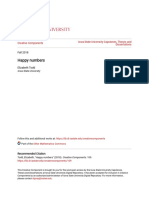0% found this document useful (0 votes)
21 views9 pagesString Questions
The document contains multiple Java code snippets demonstrating various programming tasks, including reversing strings, finding the longest common prefix, checking for K-anagrams, identifying pangrams, converting Roman numerals to integers, checking divisibility by 7, counting substrings with equal numbers of 0s, 1s, and 2s, replacing substrings, and maximizing the sum of minimum values in fruit pairs. Each task is explained with input examples and corresponding output. The code snippets are designed to be run in an online Java compiler.
Uploaded by
avanishmore25Copyright
© © All Rights Reserved
We take content rights seriously. If you suspect this is your content, claim it here.
Available Formats
Download as TXT, PDF, TXT or read online on Scribd
0% found this document useful (0 votes)
21 views9 pagesString Questions
The document contains multiple Java code snippets demonstrating various programming tasks, including reversing strings, finding the longest common prefix, checking for K-anagrams, identifying pangrams, converting Roman numerals to integers, checking divisibility by 7, counting substrings with equal numbers of 0s, 1s, and 2s, replacing substrings, and maximizing the sum of minimum values in fruit pairs. Each task is explained with input examples and corresponding output. The code snippets are designed to be run in an online Java compiler.
Uploaded by
avanishmore25Copyright
© © All Rights Reserved
We take content rights seriously. If you suspect this is your content, claim it here.
Available Formats
Download as TXT, PDF, TXT or read online on Scribd
/ 9








